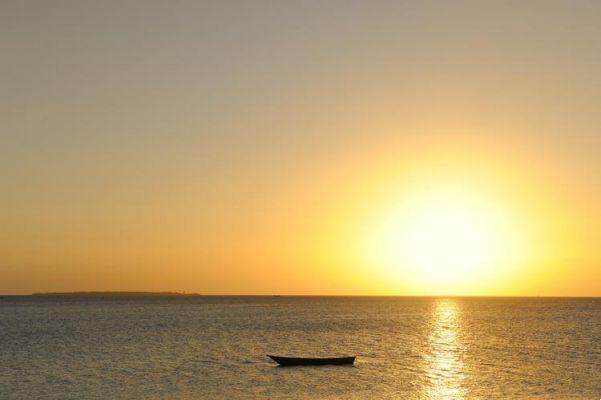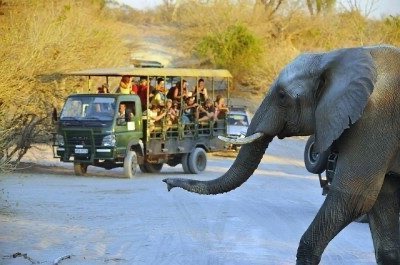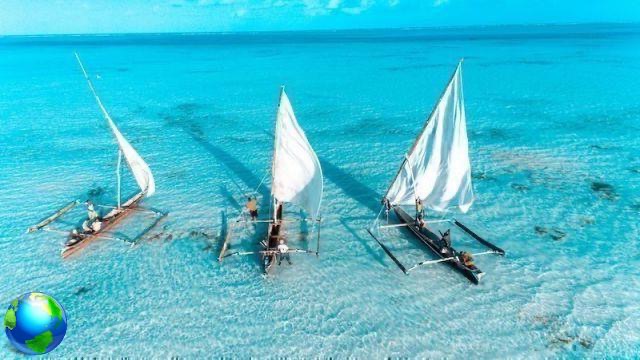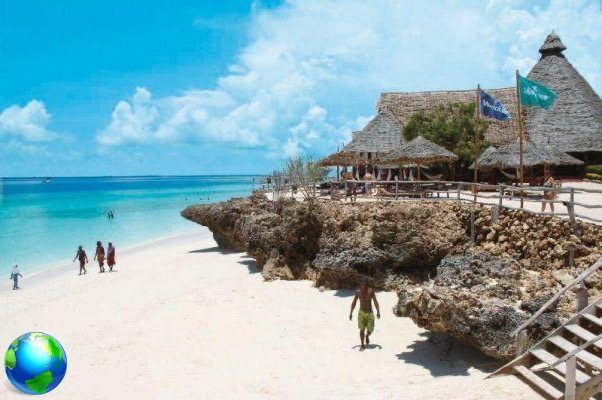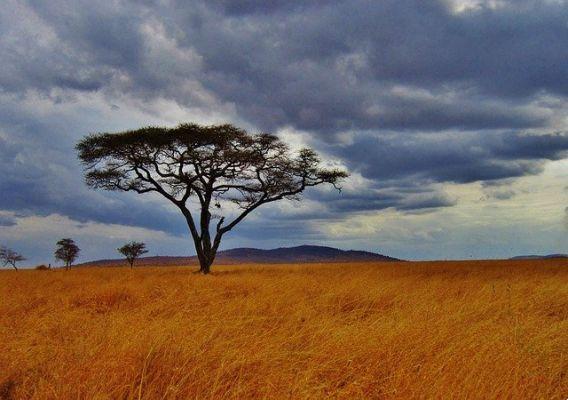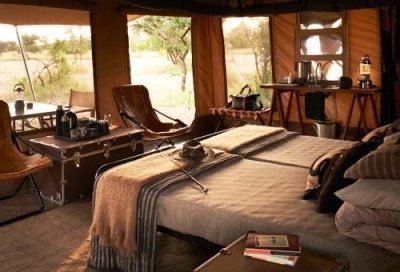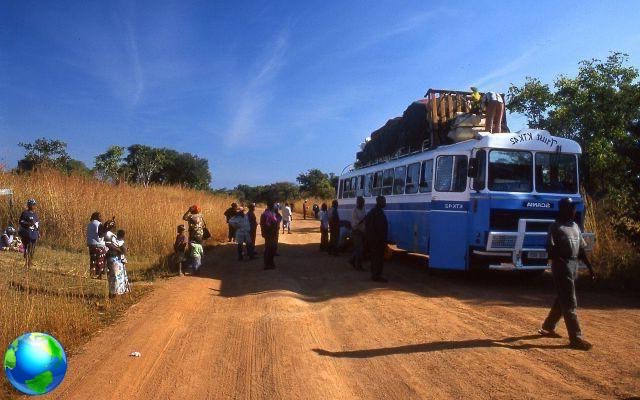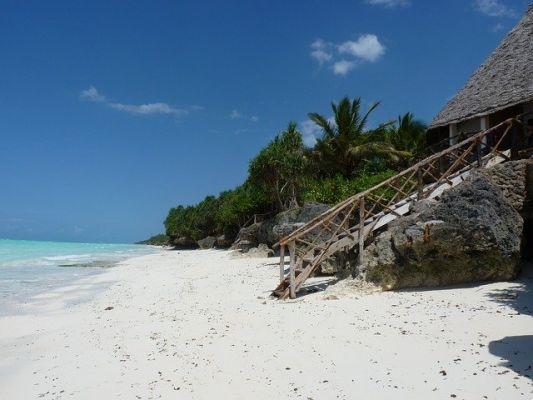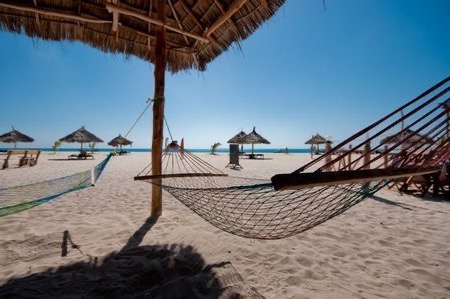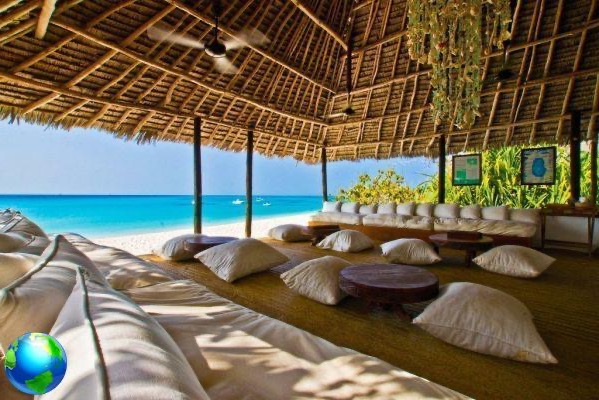Here is a very interesting travel story that will lead you to discover the history, attractions and most beautiful beaches of Zanzibar renamed with the name of the Island of Happiness.
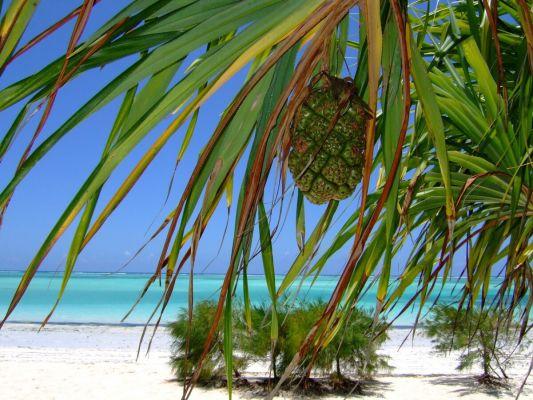
- Zanzibar Tanzania: history
- Zanzibar attractions and places of interest
- Zanzibar what to do and excursions
- Zanzibar tips and info
- Zanzibar pictures and photos
Zanzibar Tanzania: history
In October 20219 we were on vacation on this beautiful island ofIndian Ocean.
Before starting this beautiful travel story I want to give you some news about its history of this magical place
Zanzibar belongs to the Tanzania since 1964 when the newly elected president Sheikh Abeid Karume accepted the proposal of the president of Tanganyika to join in a confederation.
Thus was born the Union of the Republic of Tanzania whose name derives from the first three letters of the two countries concerned: tan from Tanganika and zan from Zanzibar.
However theUnguja island, because that's what it was called Zanzibar originally (Zanzibar is actually the archipelago), it was subjected to various dominations over the centuries.
Even before the arrival of the Arabs it was certainly inhabited by African populations of Bantu lineage.
In 1698 Zanzibar became part of the possessions ofOman who, experiencing a not very favorable period, decided to transfer the capital of Oman from Muscat to Zanzibar which in a few years became the largest clove market on the east coast of Africa.
The Rock Zanzibar
Between 1887 and 1892 some possessions became colonies of the Britain, Spain e Germany.
Then gradually the British Empire took control of the island.
in 1963 Zanzibar it became independent under a constitutional monarchy while in 1964 there was a revolution and in less than two weeks it became a Republic.
Il tourism it began to develop in 1990 thanks to President Salmin Amour who encouraged foreign investments.
Most resorts currently existing are Spanish and it is estimated that around 100.000 tourists arrive annually here.
In addition to tourism another source of income is the spice market, which is a state monopoly, and the cultivation of seaweed.
A Zanzibar the slave trade was practiced for centuries, first by the Arabs and then by the Dutch, because Muslims could not work as slaves on the plantations and therefore people came here to enslave Africans.

Zanzibar attractions and places of interest
We have been to Stone Town, the capital, where we visited the Anglican Cathedral of Christ which commemorates the end of the sale of slaves: in fact it was built right in the place where this trade took place and the altar is located where there was a tree in which the slaves were tied and beaten.
Inside there is a kind of bulletin board in which Dr. David Livingstone is remembered who is thought to have been one of the proponents of the fight against slavery.
Also inside the church we saw a Crucifix made with the wood of a tree that was on the place where Livingstone's heart was buried.
Not far from the Cathedral there are still the pits, which we were able to visit, where slaves were taken (on one side women and children and on the other men) for one or two nights waiting to be embarked and brought. away from the island.
Holidays Zanzibar Tanzania
Many could not manage to live huddled together without eating and drinking and died before being sold.
It is said that around 600.000 slaves were sold in Zanzibar between 1830 and 1873.
A Stone Town we visited the Old Town full of alleys, of Arab houses with doors in worked teak wood, inlaid and rich in ornaments such as spikes that were used to keep elephants away.
We also passed the house of Freddie Mercury (the voice of the Qeen who lived here up to 9 years) which is located in front of the Catholic Cathedral of St. Joseph which is usually closed because there are very few Catholics on the island.

We visited the Strong Arab inside which there are performances of music and dance and the House of Wonders, a building with very high columns and stairways decorated in silver, where a famous Sultan lived because he had 100 concubines and the first palace in Zanzibar to have electric light.
Here and there strolled women completely wrapped in black dresses or in the colorful sarongs typical of Zanzibar, the Khangas (I bought two too) with hands and feet decorated with henna in the Arabic way while the men, as we were in the highlight of the celebrations for the end of Ramadam, wore white tunics and wore linen caps on their heads embroidered white.
On the same day we did the Spice Plantation Tour where we were able to see closely and appreciate the scents of the pepper plant, ginger, lemongrass, cloves, nutmeg, vanilla, whose flower, which looks like an orchid, must be pollinated every morning and to finish that of the queen of spices or cinnamon which is obtained from the bark of a tree and which is reformed every three months.
We have also seen the lipstick plant that produces a fruit inside which there is a creamy substance that spread on the lips has the characteristics of lipstick.

We were accompanied on our tour by a local boy who spoke Italian and who explained the varieties of plants and their uses in the kitchen or in cosmetics. Here everyone speaks Italian correctly and most of them are self-taught and have learned it through tourists or by reading a lot (they also speak English and French very well).
At the end of the tour a boy climbed a coconut palm, brought one down and made us drink the milk contained in it and gave me a bucket and a necklace while my husband a hat and a tie obtained by weaving palm leaves.
We were delighted by the scents of the plants and the kindness.
We stayed at the Kendwa Rocks Beach Resort which is located in the north-east of the island and right here is the most beautiful and largest beach on the island: Kendwa Beach.

Il sea it is turquoise in color and the sand is very white and soft like talc.
The island is littered with villages but this is the best area because here the phenomenon of the tides is very low and you can always swim while in other parts the sea recedes a lot and you have to go out by boat to swim.
Thanks to the withdrawal of water, the population, which for the vast majority is devoted to fishing, pours onto the beach and begins to collect molluscs and fish that have become trapped.
Beyond the beach are the villages where i live Zanzibar and, while the men go out in the boats obtained by digging the trunks of the trees, the women and numerous boys and girls (there is no birth control here) spend several hours going up and down in search of fish.
Younger children have fun digging in the sand.
Most are all practicing Muslims so they enter the water dressed and the women and many girls have their heads covered.

My husband, who loves underwater fishing, told me that he saw a considerable amount of fish that, not at all frightened, approached him while he was swimming.
Along the shore you can see beautiful shells, starfish, and pieces of coral but, unfortunately, they cannot be collected and packaged because it is forbidden to export them and in fact at the airport, before leaving the suitcases to be loaded, they must be opened and the employees and especially the women meticulously check their contents and if they find shells or sand they pay very high fines.
One afternoon we went for aexcursion a boat, starting directly from our beach, and we headed to a fishing village where we saw how a boat is built. They do everything by hand and have tools that have been created by them many times.
Inside the village we could see the houses in which they live, they are constructions made of brick or tuff, covered with sheet metal roofs that create a rise in temperature inside but last forever while they explained to us that the roofs made with the coconut palm they make the environment cooler but last from three to six years.
They are not plastered, the floor is not paved, sometimes doors and windows are missing and many sleep inside; in short, they look more like ruins than houses and have no running water.
In front of the houses there is only land where hens scratch and someone also has an African breed cow (they are thin, bony and have a hump which is a reserve of fat).
Children have fun with little.
I had brought some notebooks, pens, colors, games, T-shirts and I must say that I was moved when I started distributing them because they were shaking and competing for them.
Other than our children!

I gave three girls a dollar each and they ran home shouting for joy.
Here they feed mainly on fish, of which theIndian Ocean it is very rich, and in fruit: bananas (what a taste !!!), coconut, mango, papaya and watermelons (which are very small).
Think that the monthly salary of a policeman is 60 euros!
They have little but they are happy, they always smile and never complain; we Spaniards are used to complaining about everything.
They always ask you how you are and tell you all the time Hakuna Matata.
I liked the sentence a Zanzibari said to me: Life is sweet, too bad it doesn't last long!
In the village we ate very well: the waiters were Zanzibarini and the chef Francesco, a young Italian, always available and present.
There was also an all-Zanzibari evening in which the waiters were all in costume and we tasted local specialties, all super spicy.

Zanzibar what to do and excursions
Another day we went in the company of other Spanish tourists to do the named excursion Safari blu.
They led us to Close in the south of the island and from here with a typical boat, Dhow, on a strip of white sand, Menay Bay , where there was a blue lagoon and here I too did some snorkeling and saw multicolored fish and a dense coral reef.
Then they offered us some very fresh coconut and finally they transferred us to have lunch on theKwale Island where we were served under the trees, on the beach, a grilled prawns, tuna, sea cicadas and lobster.
And then lots of fruit, what flavors and what aromas.
Our guide, Giorgio, (the Zanzibari are called with Spanish names) showed us a baobab (the island is full of them) about 400 years old which, despite having overturned for 70 years, is still alive.
On the way back they made us stop to swim in the Mangrove Lagoon.
We are all back on the boat which this time will take us back to the place from which we started no longer by motor but by sailing.
We retrace the same landscapes of the outward journey but we realize that the strip of white sand has been swallowed by the tide and to say that a few hours before we were there.
Long Kendwa Beach you can admire numerous stalls where sarongs, necklaces, bracelets, rings, beach bags, t-shirts, wooden Masai figurines and many canvases with Masai paintings or sunsets of fire are displayed.
The sunsets, yes the sunsets are spectacular.

In this period, while autumn has begun here, a Zanzibar it is the beginning of summer.
The sun during our stay set at 18:15 pm (Zanzibar has an hour longer than us) and the show could only be admired from our beach.
Every evening, on time, I didn't want to miss this show and with camera and camera I immortalized, moment by moment, the setting of the sun god.
While walking or sunbathing, i always approach Beach Boys who pester to sell tours or to organize lobster dinners.
Then there are some Zanzibari who specialize in massages or in making braids or decorating hands and feet with henna.
Our beach was controlled by young Tanzanians dressed as Masai.

When we arrived at the village they welcomed us by performing typical dances and singing a cappella. They are very tall and very thin and they told me they earn only 12 euros per month for 50 hours of daily work.
We did another excursion to the South-West of the island, therefore to the opposite side of our village.
They had proposed the sighting of dolphins. We reached, with the usual minibus hired by the nice Giorgio, the Kizimkazi fishing village, we got on a boat and headed offshore to see the dolphins.
After about ten minutes of navigation we spotted them, they swam on the surface and occasionally dived. Some young people in our group dived and swam with them. Even if they are not tame they approach the boats and play.
The same excursion included a tour in the Jozani Forest where the only specimens of Red Colombus monkeys live (they have the back of the head, the back and the tail of red hair).
We saw them rise, descend from the branches of the trees, chase each other, play, eat the leaves: it was like watching a National Geographic documentary.

Zanzibar tips and info
Cars cost too much and then the Zanzibari to get around or take the somewhat rickety buses in which they are crammed as in a can of sardines or ride a bicycle.
Bikes are the queens of Zanzibar.
Their drivers are very fast, they sneak everywhere, a drive is on the left and the roads are almost all paved and every now and then there are checkpoints of the local police to check how many tourists pass.
Driving in Zanzibar is difficult because pedestrians walk along the side of the road as the houses are located near the road and often children and animals suddenly cross.
The national language is Swahili. We learned some words like: Asante Sana (thank you), Hakuna Matata (it doesn't matter), Nakupenda (I love you), Welcome (benvenuto), Jambo (hello).
To enter Zanzibar, once you arrive at the airport, you have to pay an entry visa of 50 dollars while to get out you need 38 dollars.
Euros are accepted everywhere even if the local currency is the Tanzanian shilling. We did not have antimalarial therapy; we have not seen the mosquitoes, perhaps there are more of them Spain.
Every night they came to take down the mosquito net on our bed and we always kept the air conditioner and the fan on.
The temperature was not excessively high because it was always mitigated by a light breeze, especially in the evening.
A Zanzibar we learned to know and appreciate the beauties of the African continent and to observe the contradictions of this area.
The riches of nature and the soil collide with the poverty of a considerable number of people who, however, are always smiling and happy.

Zanzibar pictures and photos






